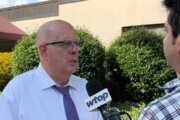Even before the COVID-19 pandemic, many schools and districts were dealing with teacher shortages. In the 2021-2022 school year, some states had more than 3,000 unfilled teacher positions, according to data gathered by researchers at Kansas State University and the University of Illinois Urbana-Champaign. And thousands of classroom teachers in some states weren’t fully certified by state standards.
The pandemic seems to have made things worse: Federal data shows an increase in resignations and retirements due to COVID-19.
Added to this, the teacher workforce is woefully out of alignment with the nation’s student population. About 80% of public school teachers are white and 77% are female, according to the most recent federal National Principal and Teacher Survey. And Black and Latino teachers are leaving the profession at higher rates than white teachers.
With declining numbers of college students earning degrees in education, a variety of programs are turning to teenagers to address these issues. Through early college programs and dual enrollment courses, these initiatives, sometimes called “grow your own” programs, allow high school students to learn teaching fundamentals and explore the profession while earning college credit.
[SEE: What to Know About ‘Grow Your Own’ Teacher Programs.]
“They get the ‘aha’ moment earlier,” says Albert Chen, acting CEO of Educators Rising, a national teacher preparation program based in Arlington, Virginia. Through partnerships with states and districts, the program provides nearly 60 lessons for high school teachers to offer aspiring educators. The classes cover core themes in teacher training, like using assessment and data and engaging in reflective practice. “We’re teaching what they’ll learn in the first year (of a bachelor’s program in teaching).”
Another program, Colorado-based Pathways2Teaching, works to boost teacher diversity and train current and future educators in culturally responsive teaching. Partnering with districts in Colorado, Louisiana, Minnesota and North Carolina, the program also trains high school teachers through weeklong online courses to offer Pathways2Teaching courses as electives at their schools. The program is dual-enrollment, so students receive both high school and college credit at partner universities like the University of Colorado.
The program’s explicit goal is to encourage students of color to become educators. More than half of high school students participating in the program are Black, Latino or Native American.
“If we look at the teacher shortage right now, who are kids most affected? Kids of color and economically challenged communities,” says Margarita Bianco, associate professor at the University of Colorado Denver‘s School of Education and Human Development. “We have to do something about it, and quickly.”
Teacher Training With an Equity Lens
Bianco, who teaches graduate and undergraduate courses in special education and educational psychology, founded Pathways2Teaching in 2010 to train high school students in teaching fundamentals while examining inequities in the educational system.
Students who complete a yearlong, three-course sequence can earn a paraprofessional certificate as well as nine college credits. Many certified paraprofessionals — educational aides who assist students — are hired back by their own districts after graduation, Bianco says. That enables student graduates to work in an environment that’s more likely to support them while they take college classes, she adds.
Among the program’s goals is to help fill gaps in the teaching workforce. In the 2017-18 school year, only 7% of math teachers were Black and 7% were Hispanic. Research also shows that children of color have less access to advanced math and science instruction, which may lead fewer of them to pursue a career in STEM education.
Pathways2Teaching courses cover how to create an equitable STEM classroom and introduce students to other areas where teacher shortages are especially acute, such as special education and multilingual education. Social justice is woven through each course’s curriculum. In the special education course, for example, students study the suspension rates at their own schools to track the often disproportionate rates for Black and Latino boys who receive special education services. The multilingual education class studies legal efforts to make English the only language used in public schools.
“For young students of color, what will attract them to teaching is knowing they’ll have an impact on their community and make change for upcoming generations,” Bianco says.
Real-World Experience
In Phoenix, education careers are the focus of a new early college high school, Phoenix Educator Preparatory, opening this fall. Designed as a four-year program providing college credit and early industry experience, the school will offer five pathways for ninth graders to choose from at the end of freshman year: elementary teaching, secondary teaching, counseling, social work and educational psychology.
In planning the school, administrators analyzed education courses at Arizona State University and designed their program along the same major themes. Juniors and seniors will do apprenticeships in local elementary schools.
“We’re trying to abolish the phrase, ‘the real world,'” says Alaina Adams, principal of Phoenix Educator Preparatory. “This isthe real world. Kids can educate.”
By providing teacher training and experience to high school students, Adams hopes to yield a more prepared and committed cohort of teacher trainees at the college level, and even reduce the amount of time they have to spend in college. This approach has particular potential to develop a diverse teacher workforce.
“Our ZIP codes ensure diversity,” says Adams. Phoenix Educator Preparatory’s district is 82% Hispanic. More than 77% of students qualify for free and reduced-price lunch programs. “If I can build a new system that reduces their student debt, then I’m committed to that.”
For Bianco, who is Latina, providing students of color with opportunities to make an impact on children’s lives is a very personal mission. As a high school student, she had a low grade-point average and was told by her guidance counselor that she wasn’t college material.
“He said I shouldn’t bother,” she recalls. After she graduated and was working as a paraprofessional, she had colleagues who had completed college. One of them took her to a college campus so she could apply in person. “I was ticked off that my advisor had underestimated my abilities. I want my students to know that I’ve become an excellent educator and they can, too.”
More from U.S. News
The Rise of High School Internships
How to Decide if You’re Ready for College
How Many AP Classes Should I Take?
Preparing High School Students to Become Teachers originally appeared on usnews.com






